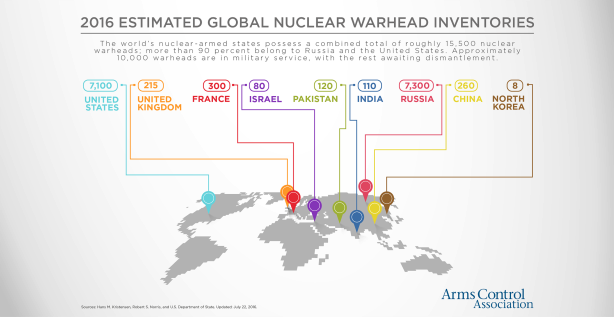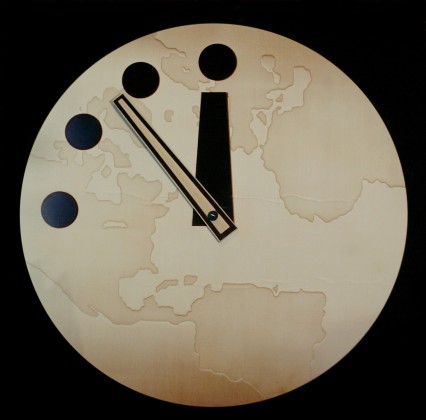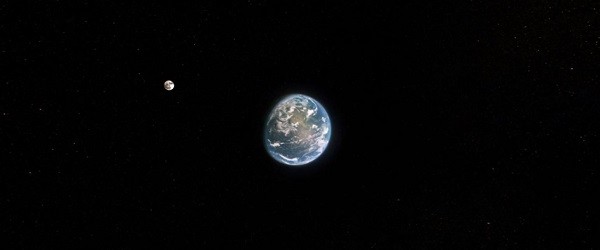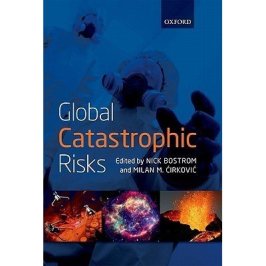Stanislav Petrov may have saved the world when he refused to tell his superiors that five Intercontinental Ballistic Missiles were incoming from the United States. On 26 September 1983, thirty-three years and three days ago, Stanislav broke protocol and reported the detection as a false alarm, though he had no way of knowing this was the case. Rather than receiving thanks from Soviet command for saving the world, he was investigated and reassigned to an insignificant post, his career prospects ruined.
Vasili Arkhipov may have also saved the world when he refused to give his assent to launch a nuclear torpedo in the middle of the Cuban Missile Crisis. The sub’s commander and political officer, two of the three personnel required to authorize a launch, had tried to convince Arkhipov to launch a nuclear torpedo when their sub was being threatened with depth charges. Had Arkhipov not refused, the USSR would have been the first nation to use a nuclear weapon in combat since World War II. Amid the tensions of the Cuban Missile Crisis, the use of a nuclear weapon probably would have led to a global nuclear war.
The threat these men saved us from is still very real today. The global nuclear arsenal stands at around 15,000 warheads, each tens to hundreds of times more powerful than the fission bombs dropped on Hiroshima and Nagasaki. The United States and Russia both have about 900 nuclear weapons on high alert, capable of being launched within minutes. Even more disturbing, there are now far more world-ending buttons than there used to be. No longer is the fate of the world solely in the hands of the USSR and NATO. In 2016, there are 9 Nuclear powers. Each one could initiate a nuclear war with the press of a button.

As countries develop, the technological difficulty of joining the nuclear club decreases. Unless there is significant international progress on nuclear proliferation, the list will continue to grow.
Since 1945, the Bulletin of the Atomic Scientists has tracked the danger of nuclear war. On the cover of the publication is a visual metaphor, the doomsday clock. Midnight represents nuclear annihilation. In 2016, the clock reads 3 minutes to midnight — the closest it has been since the especially chilly year of 1984. What makes the Bulletin consider the risk to be so high?
Nuclear arms reduction efforts have stalled. All nine nations are increasing their spending to develop new nuclear capabilities. The US alone plans to spend 1 trillion dollars on nuclear arms over the next 30 years. The relationship between the US and Russia has deteriorated since the invasion of Crimea and the conflict in Syria. Hope of a serious reduction of the nuclear arsenal is nowhere in sight. Pakistan and India continue their arms race; only time will tell whether a nuclear deterrent will be enough to keep the peace on their historically conflicted border. Israel remains in a delicate geopolitical situation amid the territorial disputes and religious tensions. North Korea has aggressively expanded their nuclear program, surprising analysts with their rapid progress. They completed their 4th and 5th nuclear tests this year, launch-tested submarine missiles and mid range missiles, and sent a satellite into space. Analysts estimate the country possesses 8 – 20 nuclear weapons and enriches enough uranium to make a new warhead every six weeks.

What would happen if the doomsday clock struck midnight, and a nuclear war ensued? No one knows for certain because it’s not an easy thing to test. In the event of a full scale nuclear war, studies suggest that in addition to the millions killed from the blasts and fallout, black carbon smoke from the burning cities would circulate in the upper atmosphere, causing significant global cooling. Agricultural regions in the US, Europe and China could face a 36 ° F drop in temperature during the summer, with an even more dramatic 63 ° F temperature drop in Russia. Growing food would be nearly impossible. Even a small scale regional war involving only 100 nuclear explosions could lead to a “mild” nuclear winter impacting the food security of hundreds of millions.
As humanity develops, there are more and more “doomsday agents” — more nations with nuclear weapons or other kinds of powerful weapon systems. If we wish to survive, to solve disease and hunger and war and build a flourishing future for humanity, we must be wiser. If we wish to expand beyond our small corner of the galaxy and explore the wonders of our cosmic inheritance, then we must learn to be more like Stanislav Petrov and Vasili Arkhipov.
Trouble is, even if exhibit the bravery of these two heroes, and countless others unnamed, we are unlikely to have our fingers on the button when the launch orders are given. This does not excuse us from acting, but does make it hard to know how to act. Without a foundational understanding of the history and present state of nuclear development, it’s hard to know where to start. Fortunately, we are not the first to consider this problem. Over the past two years I have searched for ways to personally contribute to reducing global risk. Along the way, I’ve received some good advice, which can be summed up in three points. While this article focuses on nuclear risk, these points can be applied to global catastrophic risk generally.
- Research the problem. Generate models, test your hypotheses.
- Work with effective people and organizations rather than going at it alone.
- Give directly to the best organizations if you can’t work on the problem directly.
- Research the problem. With an issue large as the threat of global nuclear annihilation, it’s tempting to want to jump in and start working on solutions. However, without an adequate understanding of the problem space, even good faith attempts at solutions are likely to be useless at best and actively harmful at worst. Taking action will look different depending on which risk factors are greatest. How likely is it that states are building cobalt bombs? How well could the US defend Japan against a nuclear strike by North Korea? Would nuclear detonations in modern cities create firestorms intense enough to alter the climate? Different answers to these questions would necessitate different strategies. Unfortunately no one is particularly good at predicting future human events, but some people are much better than others. We must understand the nuclear risk well enough to evaluate relative risk, in order to prioritize money and effort spent. For those new to the field, I have included some research suggestions at the end of this post.
- Don’t work alone. While this may seem obvious, it can be hard to coordinate with other people, and one may be tempted to act dramatically to raise awareness of the problem or influence a prominent policy maker. Not only is this likely to be ineffective, it risks jeopardizing other global risk reduction efforts. This is a version of the problem Nick Bostrom calls the unilateralists curse, where the greater number of agents, the greater the risk of accidental harmful action. I do not mean to imply that there is no room to innovate or create new organizations or actions. There are over twenty anti-nuclear organizations, and I doubt most are very effective. As technology changes and new threats come into place, I think fresh strategies are necessary. However, ignoring accumulated wisdom and contacts from established organizations would be ill-advised. In my own search, I have found constant, quality material from organizations like the Bulletin of Atomic Scientists and the Future of Life Institute. Working with these organizations will increase our chances of success. See the end of the post for a list.
- Give to effective organizations. The strategy of “earning to give” has been well-discussed in the Effective Altruism community. For those who possess skills to work directly in research or policy, I think direct work will have a greater impact than earning to give. However, it is not practical for many people to switch careers or fields of study. Giving money to organizations does not look as sexy as literally refusing to give the command to start a nuclear war, but it’s still important. Donations help these organizations to hire researchers, writers, and operational staff. Giving to prevent catastrophe and safeguard human civilization is awesome!
The threat of nuclear war certainly isn’t the only problem we face in the twenty-first century. We also must face biological weapons, artificial intelligence, and yet unknown technologies if we are to survive. Yet humans like Stanislav Petrov and Vasili Arkhipov provide hope that we can still do the right thing. Despite the inordinate number of nuclear weapons poised to obliterate our future, we are still here. If we leverage our skills and resources, we may be able to make the world just a little bit safer. My friends, please, join the effort to safeguard humanity and build a brilliant future.

Organizations
- The Bulletin of Atomic Scientists
- Future of Life Institute
- Future of Humanity Institute
- Global Catastrophic Risk Institute
- Union of Concerned Scientists
Research Suggestions
Global Catastrophic Risks, a collection of research around global risk, from natural risks to nuclear war to artificial intelligence, edited by Nick Bostrom and Milan Cirkovic. Chapters 5, 15, 18, and 19

Wikipedia articles:
- Nuclear weapon
- Nuclear winter
- Nuclear proliferation
- List of states with nuclear weapons
- List of nuclear weapons
- North Korea and weapons of mass destruction
- Cobalt bomb
- Mutually assured destruction
Journal articles:
- Critique of Nuclear Extinction – Martin 1982
- Long-term biological consequences of nuclear war – Ehrlich et al. 1983
- Nuclear winter revisited with a modern climate model and current nuclear arsenals: Still catastrophic consequences – Robock et al. 2006
- Climatic effects of regional nuclear conflicts – Robock et al. 2007
- Confronting the threat of nuclear winter – Baum 2015

Thanks for the interesting article. I think that not working alone is most important point here, but unfortunately it is spoiled by obvious status games, as everybody want to work with higher status peers. But some frameworks exist which was able to overcome this obstacle, like wikipedia.
LikeLike